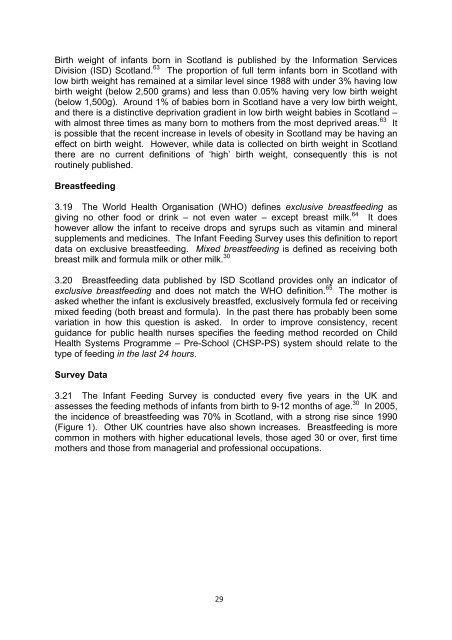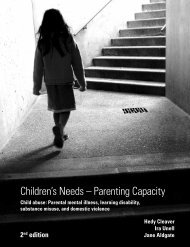Improving Maternal and Infant Nutrition: A Framework for Action
Improving Maternal and Infant Nutrition: A Framework for Action
Improving Maternal and Infant Nutrition: A Framework for Action
Create successful ePaper yourself
Turn your PDF publications into a flip-book with our unique Google optimized e-Paper software.
Birth weight of infants born in Scotl<strong>and</strong> is published by the In<strong>for</strong>mation ServicesDivision (ISD) Scotl<strong>and</strong>. 63 The proportion of full term infants born in Scotl<strong>and</strong> withlow birth weight has remained at a similar level since 1988 with under 3% having lowbirth weight (below 2,500 grams) <strong>and</strong> less than 0.05% having very low birth weight(below 1,500g). Around 1% of babies born in Scotl<strong>and</strong> have a very low birth weight,<strong>and</strong> there is a distinctive deprivation gradient in low birth weight babies in Scotl<strong>and</strong> –with almost three times as many born to mothers from the most deprived areas. 63 Itis possible that the recent increase in levels of obesity in Scotl<strong>and</strong> may be having aneffect on birth weight. However, while data is collected on birth weight in Scotl<strong>and</strong>there are no current definitions of ‘high’ birth weight, consequently this is notroutinely published.Breastfeeding3.19 The World Health Organisation (WHO) defines exclusive breastfeeding asgiving no other food or drink – not even water – except breast milk. 64 It doeshowever allow the infant to receive drops <strong>and</strong> syrups such as vitamin <strong>and</strong> mineralsupplements <strong>and</strong> medicines. The <strong>Infant</strong> Feeding Survey uses this definition to reportdata on exclusive breastfeeding. Mixed breastfeeding is defined as receiving bothbreast milk <strong>and</strong> <strong>for</strong>mula milk or other milk. 303.20 Breastfeeding data published by ISD Scotl<strong>and</strong> provides only an indicator ofexclusive breastfeeding <strong>and</strong> does not match the WHO definition. 65 The mother isasked whether the infant is exclusively breastfed, exclusively <strong>for</strong>mula fed or receivingmixed feeding (both breast <strong>and</strong> <strong>for</strong>mula). In the past there has probably been somevariation in how this question is asked. In order to improve consistency, recentguidance <strong>for</strong> public health nurses specifies the feeding method recorded on ChildHealth Systems Programme – Pre-School (CHSP-PS) system should relate to thetype of feeding in the last 24 hours.Survey Data3.21 The <strong>Infant</strong> Feeding Survey is conducted every five years in the UK <strong>and</strong>assesses the feeding methods of infants from birth to 9-12 months of age. 30 In 2005,the incidence of breastfeeding was 70% in Scotl<strong>and</strong>, with a strong rise since 1990(Figure 1). Other UK countries have also shown increases. Breastfeeding is morecommon in mothers with higher educational levels, those aged 30 or over, first timemothers <strong>and</strong> those from managerial <strong>and</strong> professional occupations.
















